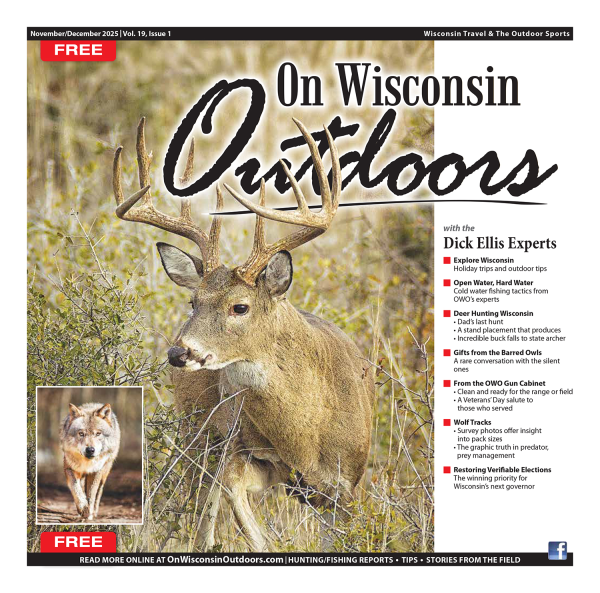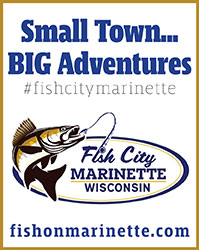DNR Weekly News Update for June 11, 2019
Weekly NewsPublished - June 11, 2019 by the Central Office
- Central Sand Plains Ecological Landscape public meeting cancelled
- Five lucky resident hunters getting ready for Wisconsin's second managed elk hunt
- Wisconsin's wolf population remains healthy, stable
- Wisconsin ruffed grouse survey results indicate an increase in breeding grouse
- WNR magazine tells comeback tale for trumpeter swans
- Lake Superior fisheries management update
- Blue-green algae bloom season is approaching
- Red Cliff Band of Lake Superior Chippewa, Franciscan nuns honored for invasive species work
- Monarchs have arrived; now's the time to plant milkweed and native flowers to help them
Central Sand Plains Ecological Landscape public meeting cancelled
A June 18 Department of Natural Resources public meeting for the Central Sand Plains Ecological Landscape regional master plan has been cancelled. The regional planning process is on hold pending collection of additional information needed to inform the planning process.
________________________
Five lucky resident hunters getting ready for Wisconsin's second managed elk hunt
Contact(s): Kevin Wallenfang, DNR deer and elk ecologist, 608-206-1107
MADISON - Following a 30-day application period, the Wisconsin Department of Natural Resources conducted the random drawing for four lucky residents who will have the opportunity to participate in the 2019 elk hunting season.

Dan Vandertie with a bull elk harvested in Wisconsin's first managed elk hunt in November 2018. Five more hunters will have the chance to pursue elk this fall.Photo credit: Dan Vandertie
"I would like to sincerely thank all those who applied for an elk license," said Kevin Wallenfang, DNR deer and elk ecologist. "It was a privilege to call all the winners and personally congratulate them. Each one recognizes that this will be a unique and exciting experience."
Over 23,000 Wisconsin residents entered the drawing for one of four once-in-a-lifetime elk tags. The winners were from the cities of Cameron, Cumberland, Grand View and Medford. The fifth license has already been awarded through a raffle conducted by the Rocky Mountain Elk Foundation. The winner was drawn at the RMEF state banquet in Wausau on June 1 and is from Hazel Green.
Although the number of applicants is down from last year, the funding brought in through this application process as well as the additional $7,800 that was donated, will be used to support habitat management and research to benefit Wisconsin's growing elk population and a variety of other wildlife as well.
"Last year's hunters collected some very nice bulls and great stories of the hunt, so we're looking forward to continued success within the elk program that provides more hunting and elk viewing opportunities in the future," said Wallenfang.
Wallenfang adds that the hunt has brought a new level of awareness to many people who were unaware that Wisconsin has elk in the state. "Elk viewing, especially in the fall, is adding a welcomed boost to local communities as people travel to hear elk calls and catch a glimpse of elk in their natural habitat."
The 2019 elk hunting season will occur only in the Clam Lake elk range in parts of Sawyer, Bayfield, Ashland and Price counties in far north-central Wisconsin where the original restoration effort was initiated with 25 elk from Michigan in 1995.
The herd is projected to be as high as 230 animals this year, not including more than 50 elk that are currently in quarantine as part of the final year of reintroduction efforts. Those elk will not be allowed for harvest during this year's hunt.
For more information regarding elk in Wisconsin, go to dnr.wi.gov and search keyword "elk." To receive email updates regarding current translocation efforts, visit dnr.wi.gov and click on the email icon near the bottom of the page titled "subscribe for updates for DNR topics." Then follow the prompts and select the "elk in Wisconsin" and "wildlife projects" distribution lists.
________________________
Wisconsin's wolf population remains healthy, stable
Contact(s): Scott Walter, DNR large carnivore specialist, (608) 267-7865
MADISON - Extensive monitoring efforts by more than 100 volunteer trackers and Department of Natural Resources staff suggest that Wisconsin's wolf population is stable while remaining well above established population goals. Data collected during track surveys this past winter reveal an overwinter minimum wolf count of 914-978 wolves, similar to the 905-944 wolves detected during the 2017-2018 count. The state's wolf population had been increasing steadily since the early 1990s but appears to have stabilized over the last few years. The number of wolf packs detected during surveys increased slightly, from 238 packs last year to 243 this past winter.

A gray wolf. This winter's minimum wolf count showed stable population numbers.Photo credit: DNR
Wolf surveys are conducted annually during winter when snow cover affords suitable tracking conditions. At that time of year, the wolf population is at its lowest point, so the results of these surveys are considered minimum counts. The population increases every spring with the birth of pups, then declines throughout the remainder of the year due to dispersal and various mortality factors.
Although wolves remain classified as endangered under the Federal Endangered Species Act, the U.S. Fish & Wildlife Service recently proposed removing wolves from the endangered species list. Such a move would restore management authority to the state and allow a more flexible approach to wolf management.
"While we can credit the Endangered Species Act with allowing wolves to regain their important role in our wildlife community, there's simply no biological rationale for maintaining current federal protections. Delisting would allow managers a fully-integrated set of management tools with which to address issues such as the depredation of livestock and pets," noted DNR large carnivore specialist Scott Walter.
To view a summary of wolf monitoring information and to learn more about wolves in Wisconsin, visit dnr.wi.gov and search keyword "wolf." To learn more about the volunteer tracking program and opportunities to participate, search keywords "wolf volunteer tracking." Classes for new volunteer wolf trackers will be held during fall of 2019.
________________________
Wisconsin ruffed grouse survey results indicate an increase in breeding grouse
Contact(s): Mark Witecha, DNR upland wildlife ecologist, 608-267-7861
MADISON - Roadside ruffed grouse surveys completed this spring show statewide drumming activity increased 41% between 2018 and 2019. This increase aligns with the generally predictable grouse population cycle. The large increase in 2019 has made up for much of the unanticipated decline seen in 2018 drumming surveys and appears to put Wisconsin back on track for approaching the next cyclical high in the ruffed grouse population. For complete survey results, visit dnr.wi.gov and search keywords "reports."
"Grouse are an important resource to Wisconsin's outdoor enthusiasts and economy," said Mark Witecha, Wisconsin Department of Natural Resources upland wildlife ecologist. "As we enter the brood rearing season, weather conditions over the coming weeks will be critical in determining what grouse enthusiasts see in the grouse woods this fall, but increased drumming activity is a good sign that there were more breeding grouse on the landscape this year."

Summer ruffed grouse surveys in spring 2019 showed statewide drumming activity increased 41 percent over 2018.Photo credit: Jerry Davis
Roadside surveys to monitor the number of breeding grouse have been conducted by staff from the department, U.S. Forest Service, tribal employees and numerous grouse enthusiasts and volunteers since 1964.
The survey results showed a 41% increase statewide over 2018 levels. The central part of the state showed an increase of 35% in drumming activity, and the northern forest showed an increase of 48% in drumming activity. These two areas comprise the primary grouse range in Wisconsin. Decreases in drumming activity detected by the roadside survey occurred in the southwest part of the state (-17%) as well as the southeast (-50%), but these areas are not within the primary range for grouse. The drumming activity in southwestern and southeastern Wisconsin are at or near historic lows and likely would not significantly add to grouse abundance in the state.
"Ruffed grouse rely on dense, young forest cover resulting from disturbances such as fire and logging," said Witecha. "Beyond actively managing state-owned lands, Wisconsin DNR is working to provide suitable grouse habitat through collaborative efforts such as the Wisconsin Young Forest Partnership [exit DNR] and jointly-funded Forest Wildlife Specialist positions with Ruffed Grouse Society and USDA-Natural Resources Conservation Service. These partnerships provide technical and financial assistance for delivering young forest management on private lands, benefitting ruffed grouse and other wildlife species by helping maintain healthy and diverse forest communities."
The department is currently working with partners to develop a ruffed grouse management plan. The draft plan will be released for public review later this summer, with associated public meetings to be held during the public comment period.
For more information regarding grouse hunting in Wisconsin, search keywords "ruffed grouse hunting."
To learn more about managing habitat for ruffed grouse and other wildlife species, search keywords "young forest."
________________________
WNR magazine tells comeback tale for trumpeter swans
Contact(s): Andrea Zani, managing editor, 608-267-9517
MADISON - Once extirpated from Wisconsin, trumpeter swans are now back and no longer endangered in the state thanks to a recovery program that began 30 years ago with careful egg collection in remote Alaska. The latest issue of Wisconsin Natural Resources magazine has in-depth details of that inspiring recovery straight from the DNR biologists who were involved in the groundbreaking efforts.

Trumpeter swans grace the cover of the summer issue of Wisconsin Natural Resources magazinePhoto credit: DNR
Another 30th anniversary is celebrated in the magazine - it's been three decades since the formal recognition of the dedicated Friends Groups that support and enhance properties in the Wisconsin State Park System. A special section looks at the history of Friends Groups and how this ever-growing band of tireless volunteers helps state parks, forests, trails and other properties today.
Also in the Summer issue, read about how educational programming can connect kids with the outdoors. A recent OutWiGo Girls outing is one great example, and the magazine has a photo page from that event held in May at the Kettle Moraine State Forest-Southern Unit. As a bonus, a removable card includes instructions for an OutWiGo "Bench Workout" to do at any park!
Stories on forestry and fishing are featured as well and readers can get an inside look at DNR work in those areas. Learn about the Forest Habitat Type Classification System, an important tool for foresters, and the Fish On...Wisconsin! initiative, a new offering from the fisheries program.
More fishing coverage takes readers to the Bois Brule River in Douglas County, a renowned spot for trout anglers, with four friends sharing their recollections of this beautiful river. And the historic Brule is highlighted in the magazine's "Back in the day" feature, with excerpts from a 1950 Wisconsin Conservation Bulletin.
Dragonflies and damselflies are ready for their close-up in this issue, as pages of stunning photography capture these odonates in detail. A tale of a special turkey hunt that yielded a trophy bird rounds out the Summer issue's inside pages. On the back cover, head "Outside in Wisconsin" to the Van Vliet Hemlocks State Natural Area in Vilas County.
Wisconsin Natural Resources magazine is available for $8.97 per year. Subscribe at 1-800-678-9472 or online at wnrmag.com.
________________________
Lake Superior fisheries management update
Contact(s): Brad Ray, Lake Superior Fisheries Team Supervisor, 715-779-4036
ASHLAND- The public is invited to learn about how the Wisconsin Department of Natural Resources manages the fisheries resources of Lake Superior, get updates about recent Lake Superior initiatives and provide thoughts and concerns about current management strategies at a public meeting in Ashland. The meeting will take place on June 25, 2019 at 6 p.m. at WITC-Ashland campus, 2100 Beaser Ave, Ashland, Wisconsin.
During this public meeting, the department will share information on how we manage this unique resource, get public input and ideas on how to most effectively engage stakeholders in current and ongoing management issues, and introduce the public to the new staff working on these issues.
Lake Superior is the largest freshwater lake in the world. Wisconsin waters of Lake Superior, its embayments, and tributaries offer diverse sport, charter and commercial fishing opportunities. The department strives to provide a healthy, sustainable environment to protect and enhance the Lake Superior fisheries for all users.
"Lake Superior supports year-round fishing opportunities that significantly contribute to the economic viability of the area," said Brad Ray, DNR Lake Superior fisheries supervisor.
Due to the significant, community-wide impacts of the Lake Superior fishery, the department actively engages diverse stakeholders to develop, implement, and evaluate management goals and activities. In July 2017, the department began work to update the Lake Superior Fisheries Management Plan and intends to release the first draft for public comment by the end of this summer.
"The goals and objectives established in the plan will guide practical management of Wisconsin's Lake Superior fisheries to benefit the state's citizens within the productive capacity of the resources. The public participated extensively in the making of the plan, so it will reflect the type of management desired for Lake Superior and its tributaries," Ray said.
In December 2018 the department signed a new Lake Superior Fishing Agreement with the Red Cliff and Bad River Bands of Lake Superior Chippewa. Originally signed in 1986, this agreement has guided harvest and designated refuges, restrictive use areas, and open fishing zones. Lake trout quotas, seasons, tagging, enforcement, home-use fishing, and information exchange are also described in the agreement.
"In addition, there have been some recent personnel changes in the staff tasked with managing this unique resource and we would like to take the opportunity to introduce the public to the new staff and provide an overview of both new and core aspects of the Lake Superior management program," Ray said.
For more information regarding Lake Superior management, contact Brad Ray at 715-779-4036 or via email at Bradley.Ray@Wisconsin.gov. To learn more about Lake Superior fishery management, visit dnr.wi.gov and search keywords "Lake Superior fisheries management."
________________________
Blue-green algae bloom season is approaching
Contact(s): Gina LaLiberte, DNR statewide blue-green algae coordinator Gina.LaLiberte@wisconsin.gov; 608-221-5377 OR, the Department of Health Services Media Line, 608-266-1683
MADISON -- Those heading out to lakes and rivers this summer are reminded to be on the lookout for blue-green algae, also known as cyanobacteria, on water bodies across the state. Some blue-green algae can make toxins that cause illness in people and animals who accidentally swallow, inhale, or have prolonged skin contact with the algae.

Blue green algae covers rocks with a substance similar in consistency to pea soup.Photo credit: DNR
"Blue-green algae are in all lakes and rivers in Wisconsin, but they only become a problem when they grow to high levels, called blooms," said Gina LaLiberte, DNR's statewide blue-green algae coordinator.
Blooms tend to grow when there is a lot of sunlight, water temperatures and nutrient levels are high, and there is little wind. In Wisconsin, blooms typically peak from July through September, though can also occur in June or later in the fall if conditions are favorable. Actively growing blooms are usually green and have a "pea soup" appearance, but blooms may also appear as blue, white, red, or brown scums that may be foamy, streaky, or in mats or clumps.
While not all blue-green algae make toxins, the presence of blooms in lakes, ponds or rivers may indicate a potential health risk. Most beaches in the state are not currently monitored for blue-green algae, so it is important for the public to learn to assess water conditions for themselves.
"Choose the clearest water possible for small children and dogs, and avoid swallowing water that could contain other bacteria, viruses, and parasites," LaLiberte said.
One easy way to identify potential risk from blue-green algae is for an adult to wade into knee-deep water. If they can see their feet clearly, the risk of acute illness is low to moderate for adults. If they can't see their feet, keep children and dogs out of the water and consider having the whole family pursue another activity that day. If people have any doubts about the appearance of water, they should stay out.
Public health officials also encourage people to shower off with clean water after swimming in any lake, pond or river. Dogs should always be rinsed off with clean water to remove algae from their coat.
According to the Wisconsin Department of Health Services, Division of Public Health, common symptoms of exposure to toxic blue-green algae blooms include skin rash, gastrointestinal illness, and respiratory irritation. People experiencing symptoms that may be due to blue-green algal exposure should contact their health care provider or the Poison Center at 1-800-222-1222.
Animals have a higher risk of dying after exposure to blue-green algal toxins because they are smaller in size and may swallow large amounts of toxins from drinking lake, pond, or river water or licking algae from their coat. Symptoms in dogs can include lethargy, loss of appetite, vomiting, diarrhea or even seizures. If your animal shows any of these symptoms, contact your veterinarian immediately.
People are also encouraged to report potential algae-related illnesses in both people and animals to the Wisconsin Department of Health Services by filling out the Harmful Algae Bloom Illness or Sighting Survey [exit DNR] or by calling 608-266-1120.
To help track the occurrence of blooms around the state, blooms may be reported to the DNR at DNRHABS@wisconsin.gov. We are particularly interested in reports of especially severe or unusual bloom conditions. Descriptions of bloom size, duration, location with lake, town, and county name, and photos for verification are particularly helpful.
The United States Environmental Protection Agency recently released final recreational guidelines for two blue-green algal toxins [exit DNR]. The DNR is reviewing the guidelines and will consider using them to set state standards for swimming advisories, water quality criteria, or both.
The DNR continues to implement strategies to improve water quality in Wisconsin's lakes and streams with support from Governor Evers' Year of Clean Water. Water quality for Wisconsin residents and visitors is of highest priority for the DNR. More information is available by searching the DNR website at dnr.wi.gov.
________________________
Red Cliff Band of Lake Superior Chippewa, Franciscan nuns honored for invasive species work
Contact(s): Tara Bergeson, DNR Invasive Species Team Coordinator, 608-264-6043
MADISON - The Red Cliff Band of Lake Superior Chippewa, the Franciscan Sisters of Perpetual Adoration in La Crosse, and the Village of Fox Point's president and weed commissioner are among Wisconsinites recognized as "Invader Crusaders" for their significant contributions to prevent, control or eradicate invasive plants and animals.

Winners of the 2019 Invader Crusader Awards pose for pictures after a June 5 ceremony in Madison.Photo credit: Jane Simkins
The Invader Crusader awards were presented by the Wisconsin Invasive Species Council and the Department of Natural Resources during a June 5 ceremony in Madison at Olbrich Botanical Gardens as part of Invasive Species Action Month. Invasive species are nonnative plants and animals that can harm Wisconsin's ecosystems, economy and in some cases, public health. Emerald ash borer, quagga mussel, common buckthorn, giant knotweed, sudden oak death pathogen, gypsy moth, garlic mustard and purple loosestrife are all examples.
The action month aims to engage people in taking actions to prevent spreading invasive species in their work and recreational activities, and to recognize outstanding work done to address invasive species by volunteers and natural resource professionals.
During the award ceremony, DNR Deputy Secretary Elizabeth Kluesner thanked the individual and organizational recipients for their hard work and dedication, which benefit all who live, work and play in Wisconsin. "Today, we celebrate the results of your work - lakes and lands that are given a chance to recover after many hours of hard work and dedication to control and manage invasive species," she says.
Tom Buechel, chair of the Wisconsin Invasive Species Council, which is advisory to DNR, Gov. Tony Evers and the Wisconsin Legislature on invasive species issues, told award winners that they take fighting invasive species to the next level.
"You are transforming local hands-on management into teaching and organizing opportunities to broaden the impact of your efforts."
Invader Crusader awards are given in several categories, recognizing individuals and groups, both professional and volunteer, and are selected by the Wisconsin Invasive Species Council. Nominations come from citizens and organizations. The honorees and a brief description of why they received the award follows; longer descriptions are available on the Wisconsin Invasive Species Council website [exit DNR].
Professional group award winners
The Aldo Leopold Foundation is recognized for its active role in establishing and managing the Leopold-Pine Island Important Bird Area near Baraboo, including significant work to control invasive species, and for helping develop the next generation of conservation leaders. The 16,000-acre area is identified as one of Wisconsin's best bird habitats and consists of lands owned by several public and private entities.
The Red Cliff Band of Lake Superior Chippewa is recognized for a highly ambitious invasive species project to eradicate and replace nonnative phragmites from three wastewater treatment plants in northern Wisconsin. Project leaders Chad Abel and Gabrielle VanBergen secured funding from the Great Lakes Restoration Initiative. Their work made it possible to help protect thousands of acres of shoreline in northern Wisconsin, improving the health of Lake Superior, its watersheds and the lives and livelihoods of people who live there.
The Wisconsin Department of Agriculture, Trade and Consumer Protection's Nursery Inspector Team monitors over 1,000 plant growers and dealers with the goal of detecting and halting the sale of regulated invasive species. The inspectors' work helps prevent the introduction of invasive species to Wisconsin's natural areas and the subsequent efforts that would be needed to manage them.
Volunteer group award winners
The Woodland Dunes Barberryans have contributed thousands of hours to help address invasive species at the Woodland Dunes Nature Center and Preserve in Two Rivers, including helping plant 3,000 trees annually over four years and native plants in areas hit by the emerald ash borer, an invasive insect that kills ash trees. The Barberryans also engage hundreds of citizens from school-age children to college interns and adult peers in habitat restoration and land management projects.
The Franciscan Sisters of Perpetual Adoration created a management plan committed to vigorous control of invasive species on their 200-acre property. After eight years of work, nearly all mature invasives have been removed and they have treated 20 acres of invasive species on adjoining private properties to reduce the amount of invasive seed that washes into a trout stream watershed.
Volunteer individual award winners
Rod Sharka has eradicated invasive honeysuckle at Tenderfoot Reserve's 900+ acres as their volunteer land manager and has built partnerships with neighboring landowners and trained them to survey, map and manage honeysuckle infestations.
Douglas H. Frazer, president and weed commissioner for the Village of Fox Point, has helped Fox Point become a municipal leader in identifying and eradicating invasive species - through community engagement, education, availability of removal equipment and best of all - humor. He also spearheaded the enactment of a new Village ordinance banning garlic mustard and buckthorn.
Michael Vahldieck has been a dedicated and hardworking volunteer for Dane County Parks, working diligently to detect, map and remove invasive species. His mapping and control work at Walking Iron County Park helped save a high-quality remnant sand prairie from brush encroachment.
Donna VanBuecken has worked with invasive species for over 40 years, beginning as an at-large member of the Wild Ones and then as a founding member and longtime board member of the Fox Valley chapter. She was also one of the founding members of the Invasive Plants Association of Wisconsin, and does invasive species outreach to schoolchildren as well as hunting and fishing groups.
Professional individual award winners
Maureen Ferry, anaquatic invasive species monitoring specialist with the DNR, was recognized for developing new monitoring protocols for streams and wetlands, and decontamination procedures for all DNR staff to follow to prevent accidentally spreading invasive species during field work. Her efforts have provided Wisconsin a better picture of where invasive species are located, allowing for timely, appropriate management decisions to protect areas not yet affected by invasive species.
Emily Heald, water program coordinator at North Lakeland Discovery Center in Manitowish Waters, has managed lake and river protection programs in Vilas County townships, engaging people of all ages with creative approaches, like the "Float Your Boat" trivia contest in which contestants answered trivia questions about aquatic invasive species and lake history from their pontoon boats.
________________________
Monarchs have arrived; now's the time to plant milkweed and native flowers to help them
Contact(s): Brenna Jones, DNR conservation biologist, 608-267-0797; Paul Skawinski, WI Monarch Collaborative Urban & Greenspace Committee Co-Chair, 715-346-4853
MADISON - Monarch butterflies have arrived in Wisconsin after a 1,000-mile journey from the southern U.S. and are looking for milkweed to lay their eggs on. A coalition dedicated to conserving these summertime treasures is asking residents to provide more habitat for monarchs this summer and in coming years.

Add flowers like this showy blazing star to provide nectar for monarch butterflies.Photo credit: Paul Skawinski
The group, the Wisconsin Monarch Collaborative [exit DNR], is working to help reverse an over 80% decline over the last two decades in the eastern U.S. monarch population that breeds in Wisconsin and other Midwestern states. The group advises that the best, most effective way to do that is to plant native milkweed, since milkweeds are the only source of food monarch caterpillars will eat and is a limiting factor in the butterfly's population.
"Now is a great time to plant native species to help monarchs in Wisconsin," says Paul Skawinski, co-chair of the Wisconsin Monarch Collaborative Urban & Greenspace Committee and President of Wild Ones Central Wisconsin Chapter.
"The monarchs are back in our area and are searching neighborhoods for milkweeds to lay eggs on. Everyone can do their part by just adding a few native flowers and milkweeds to their existing landscaping or by starting a brand new native garden."
Many native plant nurseries around the state have large, healthy potted plants available, and some late summer bloomers planted now will likely flower this year, he says.
The Wisconsin Monarch Collaborative is composed of 70 groups and individuals who formally came together in 2018 to come up with voluntary strategies to increase monarch habitat on a massive scale. Participants include representatives from the Department of Natural Resources and other state and federal agencies, utilities, transportation groups, agriculture groups, university researchers, conservation groups and nature centers.
The group recently released their 20-year roadmap, the Wisconsin Monarch Conservation Strategy [exit DNR], which contains overarching voluntary goals that individuals, agencies and partners can use to help support monarch populations in Wisconsin.
"Wisconsin's goal is ambitious: to add 120 million new stems of milkweed by 2038, and it will take every person, organization, and agency helping out," says Brenna Jones, who coordinates the Wisconsin Monarch Collaborative, and is a conservation biologist for DNR's Natural Heritage Conservation Program.
"Adult monarchs need nectar plants to feed on too. Fill your garden with species that are native to Wisconsin and provide nectar for monarchs from spring to fall. The monarchs produced in late summer will need to fuel up on nectar for their journey to their winter grounds in Mexico each fall."
New handouts show monarchs' favorite garden flowers and native milkweed species
Coalition members offer materials to help Wisconsinites learn more about the variety of native milkweed and suitable nectar plants. These include handouts of monarchs' favorite garden flowers selected by the collaborative's Urban & Greenspace Working Group members and Wisconsin's native milkweed species. Find more information on creating monarch habitat in urban areas, farms, protected lands and utility and road rights of way on the "Get involved" dropdown menu on the Wisconsin Monarch Collaborative website [exit DNR].
Wisconsin is in the core breeding ground for the eastern migratory population of monarchs. The state's milkweed feeds and produces several generations of the iconic black and orange butterflies each spring and summer before a final generation of Wisconsin monarchs gorges itself on wildflower nectar and embarks on a 2,000+-mile journey to central Mexico where they spend their winter resting in fir trees in the mountains.
These same long-distance fliers begin migrating north in the spring and get as far as Texas before laying eggs and dying. Their offspring take up the journey, and it is mostly this generation of butterflies that reaches Wisconsin in the spring and lays their eggs, beginning the cycle again.

A monarch egg on a milkweed leaf. Monarch caterpillars can eat only milkweed.Photo credit: Paul Skawinski
While there are many factors for the decline in monarchs, habitat loss is considered the primary concern in the states where the monarch breeds. A coalition of non-governmental organizations and citizens has petitioned the United States Fish & Wildlife Service to list monarchs as a threatened species under the Endangered Species Act. That agency's listing decision announcement was expected in summer 2019 but has recently been pushed back to December 2020.
Read how a growing number of Wisconsin residents, utilities, farmers and highway departments are helping protect and add monarch habitat in "Make a Place for Monarchs" in the April 2019 Wisconsin Natural Resources magazine. https://dnr.wi.gov/wnrmag/2019/Spring/monarch.html











